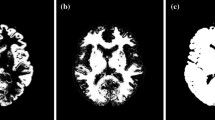Abstract
Although slice thickness accuracy is important for the performance of magnetic resonance imaging systems, long scan times are required to perform reliable measurements. Inclined slabs and wedges are conventionally used as test devices to obtain slice profiles. In this study, a novel dedicated device with a widened slab was created, and its efficacy was compared with that of a conventional wedge. The signal-to-noise ratio (SNR) of the profile and the coefficient of variation (CV) of the measured slice thickness were measured. Wide slab usage showed sufficient SNR by averaging multiple profile lines, even with single acquisition. Therefore, it is possible to substantially shorten the measurement time. When ≥ 20 lines were averaged, CV was < 1%. Furthermore, a 200-mm slab width enabled evaluation of the positional dependence of slice thickness in a single imaging. Thus, quality control of MRI slice thickness can be easily implemented with this device.







Similar content being viewed by others
References
Peltonen JI, Mäkelä T, Sofiev A, Salli E. An automatic image processing workflow for daily magnetic resonance imaging quality assurance. J Digit Imaging. 2017;30(2):163–71.
Firbank MJ, Harrison RM, Williams ED, Coulthard A. Quality assurance for MRI: practical experience. Br J Radiol. 2000;73(868):376–83.
Committee on Quality Assurance in Magnetic Resonance Imaging. 2015 Magnetic resonance imaging quality control manual. Reston: American College of Radiology; 2015.
International Standard 62464-1. Magnetic resonance equipment for medical imaging—part 1: determination of essential image quality parameters. Geneva: International Electrotechnical Commission; 2007.
National Electrical Manufacturers Association. NEMA standards publication MS 5-2010, determination of slice thickness in diagnostic magnetic resonance imaging. Washington, DC: National Electrical Manufacturers Association; 2010.
Price RR, Axel L, Morgan T, Newman R, Perman W, Schneiders N, Selikson M, Wood M, Thomas SR. Quality assurance methods and phantoms for magnetic resonance imaging: report of AAPM nuclear magnetic resonance task group no. 1. Med Phys. 1990;17(2):287–95.
Lerski RA, de Certaines JD. Performance assessment and quality control in MRI by Eurospin test objects and protocols. Magn Reson Imaging. 1993;11(6):817–33.
Yoshida R, Machida Y, Ogura T, Tamura H, Hikichi T, Mori I. Slice profile measurement using a crossed thin-ramps method in three-dimensional magnetic resonance imaging. Nihon Hoshasen Gijutsu Gakkai Zasshi. 2012;68(11):1456–66.
Kanazawa T, Ohkubo M, Kondo T, Miyazawa T, Inagawa S. Improved wedge method for the measurement of sub-millimeter slice thicknesses in magnetic resonance imaging. Radiol Phys Technol. 2017;10(4):446–53.
Nakano T. Measurement of slice thickness using a resolution phantom in magnetic resonance imaging. Nihon Hoshasen Gijutsu Gakkai Zasshi. 1993;49(1):8–11.
Higashida M, Yamazaki M, Ogura A, Inoue H, Hongou T. Measurement of slice thickness using partial volume effect in MR imaging. Nihon Hoshasen Gijutsu Gakkai Zasshi. 1998;54(8):947–52.
Yamaguchi I, Ishimori Y, Fujiwara Y, Yachida T, Yoshioka C. Measurement of slice thickness in magnetic resonance image by the impulse response. Nihon Hoshasen Gijutsu Gakkai Zasshi. 2012;68(10):1295–306.
Ihalainen TM, Lönnroth NT, Peltonen JI, Uusi-Simola JK, Timonen MH, Kuusela LJ, Savolainen SE, Sipilä OE. MRI quality assurance using the ACR phantom in a multi-unit imaging center. Acta Oncol. 2011;50(6):966–72.
Chen CC, Wan YL, Wai YY, Liu HL. Quality assurance of clinical MRI scanners using ACR MRI phantom: preliminary results. J Digit Imaging. 2004;17(4):279–84.
Torfeh T, Hammoud R, Perkins G, McGarry M, Aouadi S, Celik A, Hwang KP, Stancanello J, Petric P, Al-Hammadi N. Characterization of 3D geometric distortion of magnetic resonance imaging scanners commissioned for radiation therapy planning. Magn Reson Imaging. 2016;34(5):645–53.
Torfeh T, Hammoud R, McGarry M, Al-Hammadi N, Perkins G. Development and validation of a novel large field of view phantom and a software module for the quality assurance of geometric distortion in magnetic resonance imaging. Magn Reson Imaging. 2015;33(7):939–49.
Wang D, Doddrell DM, Cowin G. A novel phantom and method for comprehensive 3-dimensional measurement and correction of geometric distortion in magnetic resonance imaging. Magn Reson Imaging. 2004;22(4):529–42.
Author information
Authors and Affiliations
Corresponding author
Ethics declarations
Conflict of interest
The authors declare that they have no conflict of interest.
Ethical approval
This article does not contain any human or animal study.
About this article
Cite this article
Ishimori, Y., Monma, M. & Kawamura, H. Wide slab is useful for routine quality control of MRI slice thickness. Radiol Phys Technol 11, 345–352 (2018). https://doi.org/10.1007/s12194-018-0467-0
Received:
Revised:
Accepted:
Published:
Issue Date:
DOI: https://doi.org/10.1007/s12194-018-0467-0




